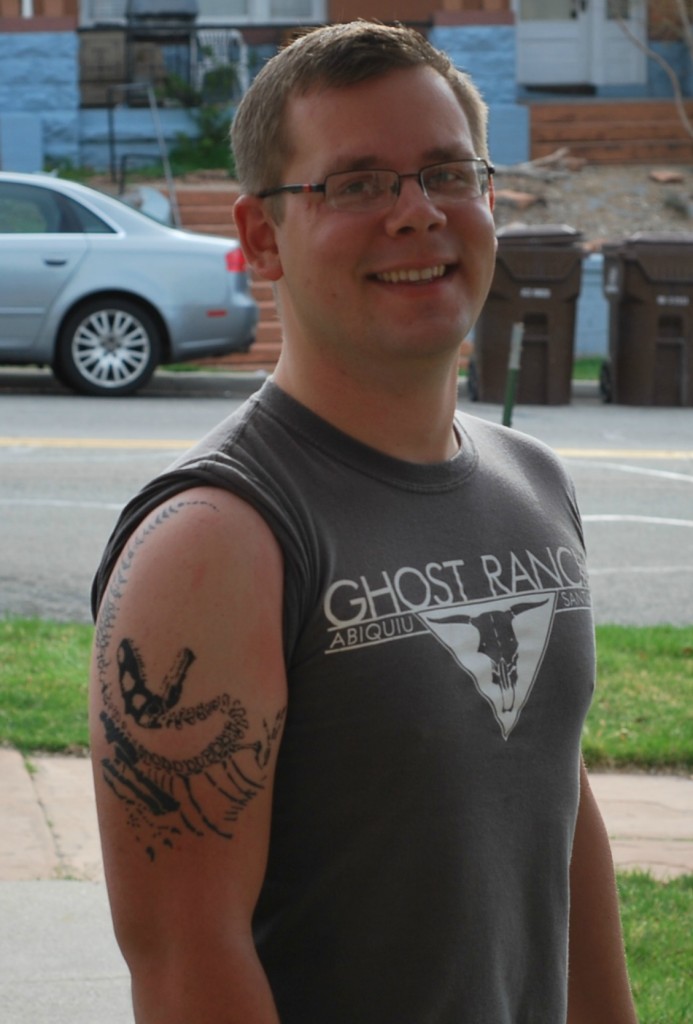Allosaurus Ink
When I decided to get my first science tattoo, the choice was clear—it had to be Allosaurus
/https://tf-cmsv2-smithsonianmag-media.s3.amazonaws.com/filer/20120330122014allosaurus-tattoo-thumb.jpg)
I have an Allosaurus on my arm. Heart of Gold Tattoo artist Jon McAffee put it there a few weeks ago. I think the tattoo—designed for me by friend and artist Glendon Mellow—came out beautifully. Contorted into the classic dinosaur death pose, the Jurassic apex predator is an expression of my passions and aspirations.
Paleontologists have uncovered scores of fascinating dinosaurs. I would have been proud to carry almost any dinosaur on my sleeve. But I knew my first science ink had to be Allosaurus. The dinosaur is not only the state fossil of Utah—I moved to the beehive state last year to get closer to dinosaurs—but the familiar predator is also an enigma.
Around 150 million years ago, when Allosaurus stalked across Jurassic Utah, the fern-covered landscape boasted an astounding diversity of huge dinosaurs. This was the time of giants such as Apatosaurus, Camarasaurus, Diplodocus, Brachiosaurus, Barosaurus and Stegosaurus, and these dinosaurs were prey for nightmarish carnivores such as Torvosaurus, Ceratosaurus and, of course, Allosaurus. There was scarcely a more fantastic time in the Age of Dinosaurs. But not all these dinosaurs were equally abundant. Among the big predators, Allosaurus is uncovered much more often than any of its knife-toothed competitors. At the Cleveland-Lloyd quarry outside Price, Utah, remains of more than 46 Allosaurus have been discovered so far, while only rare tidbits of other predators turned up. What was it about Allosaurus that made it the dominant carnivore of Jurassic Utah? I love mysteries like this. Allosaurus has been known to paleontologists for more than 130 years, but there are still some things about this creature that we just don’t know.
I asked Glendon to create the dinosaur in a death pose for a similar reason. (You can see Glendon’s step-by-step process at his blog.) If you ever find a near-complete, articulated dinosaur skeleton, chances are that the dinosaur is going to have its head thrown over its back and tail arched up. My Allosaurus got a little extra contortion for artistic purposes to bring the tail up to my shoulder, but you get the general picture. No one is entirely sure why this happens. Everything from a dinosaur’s final spasms before perishing to dessication after death have been implicated as possible causes, but the reason for the prevalence of the phenomenon is still hotly debated. Something so simple—the contortions of skeleton—is a thread leading back to unresolved questions about what happened to dinosaurs between death and discovery.
I can’t help but wonder about the life and death of an animal as beautiful and deadly as Allosaurus. And my tattoo is a reminder to keep chasing those mysteries. I do not talk about this very often—the memory is intensely embarrassing—but I never received my bachelor’s degree. After spending the better part of a decade working towards a degree in conservation ecology, I left Rutgers University just a handful of courses short of completing my program. Discouraged, disheartened and defeated do not even come close to describing how I felt. But paleontology gave me an outlet for my love of science, and writing about what I learned somehow came together into a career expressing my enthusiasm for creatures that flourished and vanished while our own ancestors were still scurrying through the undergrowth. Someday, I hope, I will go back to school and eventually commit myself to a graduate program in paleontology, but no matter what I do, I want to keep following the tales fossils have to tell. Though they might seem to simply be petrified bits of dead tissue, dinosaur bones are alive with stories about evolution and extinction. Even the most mundane bone fragment underscores powerful truths about the way life on earth has changed in an ever-evolving story of life. That’s what keeps me going back to the journal articles, museum collections and field sites where dinosaurs and ideas about dinosaurs thrive—puzzling over the long-lost life of Allosaurus enriches my own existence.
/https://tf-cmsv2-smithsonianmag-media.s3.amazonaws.com/accounts/headshot/RileyBlack.png)

/https://tf-cmsv2-smithsonianmag-media.s3.amazonaws.com/accounts/headshot/RileyBlack.png)